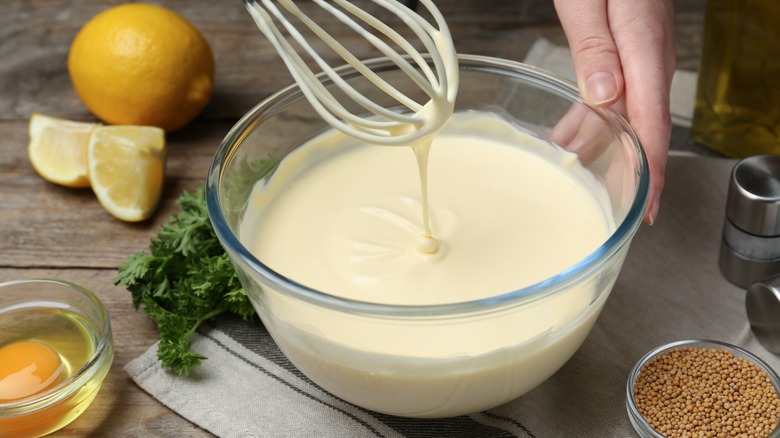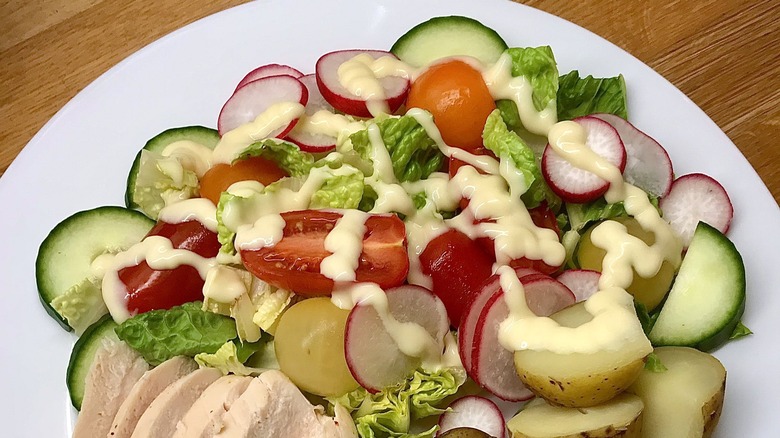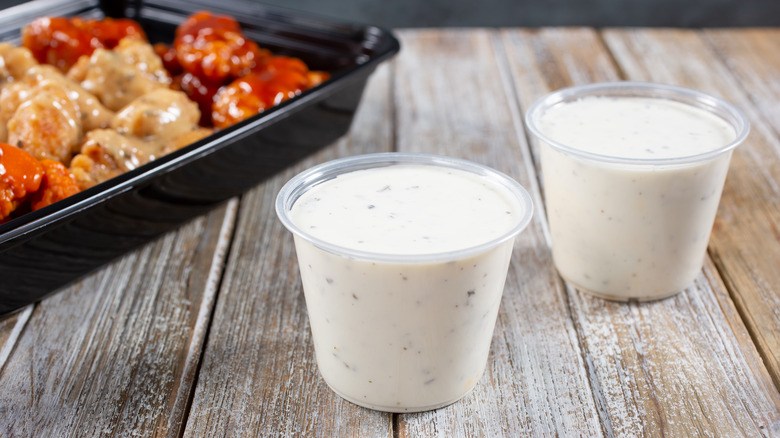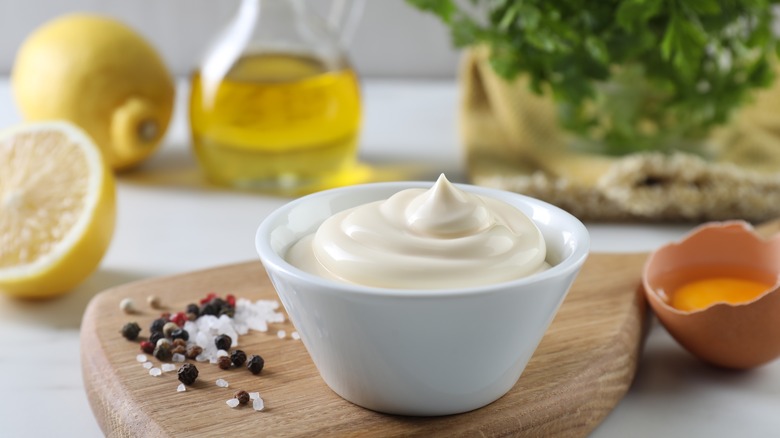Salad Cream Vs Ranch Vs Mayo: The Flavor Differences Explained
Sandwiches. Deviled eggs. Potato salad. Regular salad. There's no disputing that the culinary world would be worse off without creamy condiments. Mayonnaise is perhaps the most popular, but both it and its main ingredients serve as the base for a couple of other delicious dressings: ranch and salad cream.
Each of these rich, smooth sauces is responsible for improving the mouthfeel and flavor of all kinds of foods, from grilled shrimp and fish to baked potatoes. Often, they're enjoyed interchangeably. For instance, many Americans dunk french fries in ranch, while across the pond, countless Brits dip their chips in salad cream; and though they might be fewer in number, fries-and-mayo people walk among us — especially if you consider standard aioli to be a type of mayo (something that's up for debate). However, beyond some similarities, salad cream, ranch, and mayo can't really be confused for one another. At least, not when it comes to taste.
Shared between all three recipes are oil, usually vegetable or canola, and egg yolks. When they're emulsified with an acid like lemon juice or vinegar, you end up with a simple creamy mayonnaise. Combine the same ingredients with water, mustard, and simple seasonings to get tangy salad cream. Mix mayonnaise with buttermilk, sour cream, and some herbs for refreshing ranch. With distinctly unique recipes, each condiment boasts a different consistency and flavor. So, even though they all bring something special to the table, everyone's bound to have a personal favorite.
Salad cream, one of Britain's most beloved sauces
Heinz might be synonymous with ketchup, but the American food processing company has made a whole host of sauces fit to dress food since 1869 – including a special one you can't find stateside. Invented in 1914, salad cream was created exclusively for the British market. Sold before mayonnaise made it across the Atlantic, salad cream became a staple table sauce among the working class, achieving broader popularity in the 1940s when Brits wanted to improve bland wartime rations. Fast forward to today and it's the nation's fourth favorite condiment, despite mayo having since scandalously surpassed it in popularity, according to a consumer survey shared by Food & Drink Technology.
Only somewhat similar to mayo, salad cream is an emulsification of vegetable oil (35%), water, egg yolks, and white vinegar that's seasoned with mustard, sugar, and salt. In addition to the yellowish hue, this recipe makes the condiment rather flavorful; vinegar and mustard make salad cream's flavor sharper than mayo and even slightly sweet or spicy. The emulsified oil and water give it a thinner consistency than mayo, too, making it well-suited for its namesake: salads. Still, it's often used as a sandwich spread – and, like Americans with ranch, some Brits dunk their pizza in salad cream.
Unfortunately for anyone who hasn't tasted the classic British condiment, the Heinz product still isn't sold Stateside. Instead, the closest alternatives include Miracle Whip, Kraft Salad Dressing, and Hellmann's Salad Dressing.
Ranch, an herb- and dairy-rich dressing
Not only is Hidden Valley Ranch the most iconic brand of the delicious dressing, but it was actually a real place in the California mountains. Both ranches were created in the early 1950s by Steve Henson, a man who forever changed the condiment game. According to the Santa Barbara Independent, the dressing's original recipe, created to satisfy hungry work crews, consisted of buttermilk and mayonnaise mixed with herbs and spices including garlic, onion, pepper, and parsley.
Both homemade and store-bought ranch recipes tend to take certain liberties with the exact combination of ingredients, so it can be hard to pinpoint exactly what it will taste like. For instance, it's common for the herbaceous dressing to include dill, which gives it a distinctly grassy and almost citrusy yet savory flavor. Ranch also features a sourness from the buttermilk and occasional addition of sour cream or Greek yogurt. These ingredients, combined with mayo, make the condiment super rich and creamy, although it still usually has a relatively runny consistency for easy pouring, comparable to salad cream. However, unlike the classic British condiment's inclusion of sugar, ranch tends to be more savory than sweet.
The creamy dressing's refreshing flavor makes it a reliable dip for everything from cheesy pizza to fresh veggies. But really, it goes great with all kinds of foods — even unexpected ones. Ranch-drizzled chicken and waffles, anyone? With ranch, it's easy to channel your culinary creativity and think outside the box.
Mayo, the most basic creamy condiment
The invention of mayonnaise is often attributed to a French chef who prepared a victory feast celebrating the capture of Port Mahon in Spain in 1756 but was short on ingredients. With no dairy available for a basic sauce, he combined eggs with olive oil instead. However, this origin story has been debated, with some accounts crediting its creation to Spaniards and others claiming the condiment was invented in Bayonne, the Basque Country's capital.
What isn't so controversial is the sauce itself. Unlike salad cream's astringent bite and subtle sweetness or ranch's herbaceous flavor profile, mayonnaise tastes pleasantly mild and salty. This makes it easily customizable, whether you want to spice the sauce up with chile peppers or add garlic for aioli. It can also have a tangy flavor, depending on the recipe. Accordingly, people tend to have a preferred mayo brand, whether it be the classic Hellmann's or the chef-approved Kewpie.
While it's par for the course to pour salad cream or ranch over green salad, mayonnaise is the star dressing for other dishes. The versatile condiment has a smooth, relatively thick consistency, which comes from the high fat content and emulsification of a neutral-flavored oil with egg yolks. Not only does mayo's texture make it a go-to sandwich spread, but it also means it's perfect for binding ingredients in egg, tuna, and potato salads. Despite the differences between mayo, salad cream, and ranch, they all bring something unique to the dining table.



